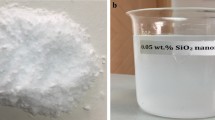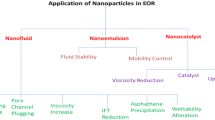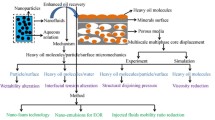Abstract
While studies on the stress sensitivity of relative permeability using conventional fluids have varying and inconclusive results, the effect of stress on relative permeability using nanofluids has not been reported. In this study, the effect of net effective stress on relative permeability and two-phase flow parameters using conventional and nanofluid was investigated. Nanoparticle retention in pores was examined by changes in nuclear magnetic resonance transverse relaxation time distribution. Nanoparticle deposition affected big pores more than small pores. As net effective stress was increased during water flooding, end-point oil and water saturations increased and end-point oil relative permeability decreased. Nanofluid–oil relative permeability showed contrasting results depending on whether the sample had adsorbed nanoparticles prior to relative permeability measurements. For the sample that had adsorbed nanoparticles prior to subsequent stress increments, the effect of stress was dominated by the effect of nanoparticle adsorption. However, the effect of stress took precedence over nanoparticle adsorption in samples that had no nanoparticle deposition prior to relative permeability experiments. A comparison of water–oil and nanofluid–oil relative permeabilities showed similar initial water saturations and end-point oil relative permeability changes but differing residual oil saturations and end-point water relative permeability. Mobility ratio increased in water flooding as stress increased but decreased after an initial increase in nanofluid flooding. Displacement efficiency decreased with increased stress for both water and nanofluid flooding. The results provide insights into the effect of stress on relative permeability using conventional fluids and silica nanofluid.
Similar content being viewed by others
References
Ojha, S.P.; Misra, S.; Tinni, A.; Sondergeld, C.; Rai, C.: Relative permeability estimates for Wolfcamp and Eagle Ford shale samples from oil, gas and condensate windows using adsorption-desorption measurements. Fuel 208, 52–64 (2017)
Bravo, M.C.; Araujo, M.: Analysis of the unconventional behavior of oil relative permeability during depletion tests of gas-saturated heavy oils. Int. J. Multiph. Flow 34, 447–460 (2008)
Akhlaghinia, M.; Torabi, F.; Chan, C.W.: Experimental investigation of temperature effect on three-phase relative permeability isoperms in heavy oil systems. Fuel 118, 281–290 (2014)
Wang, X.; Alvarado, V.: Analysis of capillary pressure and relative permeability hysteresis under low-salinity waterflooding conditions. Fuel 180, 228–243 (2016)
Kim, C.; Lee, J.: Experimental study on the variation of relative permeability due to clay minerals in low salinity water-flooding. J. Petrol. Sci. Eng. 151, 292–304 (2017)
Babadagli, T.; Ren, X.; Develi, K.: Effects of fractal surface roughness and lithology on single and multiphase flow in a single fracture: an experimental investigation. Int. J. Multiph. Flow 68, 40–58 (2015)
Fatt, I.: The effect of overburden pressure on relative permeability. J. Petrol. Technol. 5, 15–16 (1953)
Wilson, J.: Determination of relative permeability under simulated reservoir conditions. AIChE J. 2, 94–100 (1956)
Thomas, R.D.; Ward, D.C.: Effect of overburden pressure and water saturation on gas permeability of tight sandstone cores. J. Petrol. Technol. 24, 120–124 (1972)
Ali, H.; Al-Marhoun, M.; Abu-Khamsin, S.; Celik,M.: The effect of overburden pressure on relative permeability. In: Fifth Middle East Oil Show, vol. 15730, pp. 338–340. SPE, Manama, Bahrain (1987)
Jones, C.; Al-Quraishi, A.; Somerville, J.; Hamilton, S.: Stress Sensitivity of Saturation and End-Point Relative Permeabilities. Society of Core Analysts, Edinburgh (2001)
Al-Quraishi, A.; Khairy, M.: Pore pressure versus confining pressure and their effect on oil–water relative permeability curves. J. Petrol. Sci. Eng. 48, 120–126 (2005)
Gawish, A.; Al-Homadhi, E.: Relative permeability curves for high pressure, high temperature reservoir conditions. Oil Gas Bus 2, 23 (2008)
Khan, H.: Shear Induced Relative Permeability Change in Uncemented Sands. The University of Texas at Austin, Austin, TX (2009)
Oldakowski, K.: Stress Induced Permeability Changes of Athabasca Oil Sands. University of Alberta, Edmonton (2009)
Hamoud, M.; Chalaturnyk, R.; Leung, J.: Influence of geomechanical processes on relative permeability. In: Canadian Rock Mechanics Symposium, Edmonton, Canada (2012)
Cheraghian, G.: Effects of nanoparticles on wettability: a review on applications of nanotechnology in the enhanced oil recovery. Int. J. Nano Dimens. 6, 443 (2015)
Cheraghian, G.; Hendraningrat, L.: A review on applications of nanotechnology in the enhanced oil recovery part A: effects of nanoparticles on interfacial tension. Int. Nano Lett. 6, 129–138 (2016)
Cheraghian, G.; Hendraningrat, L.: A review on applications of nanotechnology in the enhanced oil recovery part B: effects of nanoparticles on flooding. Int. Nano Lett. 6, 1–10 (2016)
Sun, X.; Zhang, Y.; Chen, G.; Gai, Z.: Application of nanoparticles in enhanced oil recovery: a critical review of recent progress. Energies 10, 345 (2017)
Giraldo, J.; Benjumea, P.; Lopera, S.; Cortés, F.B.; Ruiz, M.A.: Wettability alteration of sandstone cores by alumina-based nanofluids. Energy Fuels 27, 3659–3665 (2013)
Amedi, H.; Ahmadi, M.-A.: Experimental investigation the effect of nanoparticles on the oil–water relative permeability. Eur. Phys. J. Plus 131, 1–8 (2016)
Lu, T.; Li, Z.; Zhou, Y.; Zhang, C.: Enhanced oil recovery of low-permeability cores by SiO\(_2\) nanofluid. Energy Fuels 31, 5612–5621 (2017)
Parvazdavani, M.; Masihi, M.; Ghazanfari, M.H.: Monitoring the influence of dispersed nano-particles on oil–water relative permeability hysteresis. J. Petrol. Sci. Eng. 124, 222–231 (2014)
Ju, B.; Dai, S.; Luan, Z.; Zhu, T.; Su, X.; Qiu, X.: A study of wettability and permeability change caused by adsorption of nanometer structured polysilicon on the surface of porous media. In: SPE Asia Pacific Oil and Gas Conference and Exhibition, Society of Petroleum Engineers (2002)
Ju, B.; Fan, T.: Experimental study and mathematical model of nanoparticle transport in porous media. Powder Technol. 192, 195–202 (2009)
Ju, B.; Fan, T.; Li, Z.: Improving water injectivity and enhancing oil recovery by wettability control using nanopowders. J. Petrol. Sci. Eng. 86, 206–216 (2012)
Hassler, G.; Brunner, E.: Measurement of capillary pressures in small core samples. Trans. AIME 160, 114–123 (1945)
Gupta, R.; Maloney, D.R.: Intercept method—a novel technique to correct steady-state relative permeability data for capillary end effects. SPE Reserv. Eval. Eng. 19, 316–330 (2016)
Anderson, W.G.: Wettability literature survey part 5: the effects of wettability on relative permeability. J. Petrol. Technol. 39, 1,453–451,468 (1987)
Abdallah, W.; Buckley, J.S.; Carnegie, A.; Edwards, J.; Herold, B.; Fordham, E.; Graue, A.; Habashy, T.; Seleznev, N.; Signer, C.: Fundamentals of wettability. Technology 38, 268 (1986)
Peters, E.J.: Advanced Petrophysics: Dispersion, Interfacial Phenomena/Wettability, Capillarity/Capillary Pressure, Relative Permeability, vol. 2. Greenleaf Book Group, Austin (2012)
Li, S.; Kaasa, A.T.; Hendraningrat, L.; Torsæter, O.: Effect of silica nanoparticles adsorption on the wettability index of Berea sandstone. Paper SCA2013-059 Presented at the International Symposium of the Society of Core Analysts Held in Napa Valley, California, USA, pp. 16–19 (2013)
Hendraningrat, L.; Torsæter, O.: Effects of the initial rock wettability on silica-based nanofluid-enhanced oil recovery processes at reservoir temperatures. Energy Fuels 28, 6228–6241 (2014)
Torsater, O.; Engeset, B.; Hendraningrat, L.; Suwarno, S.: Improved oil recovery by nanofluids flooding: an experimental study. In: SPE Kuwait International Petroleum Conference and Exhibition. Society of Petroleum Engineers (2012)
Wasan, D.T.; Nikolov, A.D.: Spreading of nanofluids on solids. Nature 423, 156 (2003)
Chengara, A.; Nikolov, A.D.; Wasan, D.T.; Trokhymchuk, A.; Henderson, D.: Spreading of nanofluids driven by the structural disjoining pressure gradient. J. Colloid Interface Sci. 280, 192–201 (2004)
Author information
Authors and Affiliations
Corresponding author
Electronic supplementary material
Below is the link to the electronic supplementary material.
Rights and permissions
About this article
Cite this article
Adenutsi, C.D., Li, Z., Aggrey, W.N. et al. Performance of Relative Permeability and Two-Phase Flow Parameters Under Net Effective Stress in Water Wet Porous Media: A Comparative Study of Water–Oil Versus Silica Nanofluid–Oil. Arab J Sci Eng 43, 6555–6565 (2018). https://doi.org/10.1007/s13369-018-3296-x
Received:
Accepted:
Published:
Issue Date:
DOI: https://doi.org/10.1007/s13369-018-3296-x




